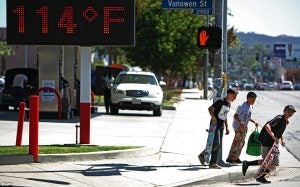This blog was co-authored by Annie Cory, Princeton Environmental Institute (PEI) Intern for EDF’s Oil & Gas Program
Just like many cities that have experienced record high temperatures in 2018, Los Angeles was hit with a heat wave of record proportions in early July, with temperatures topping 113 degrees in several parts of the county. As air conditioners across the region struggled to keep up, the heat pushed our energy grid over the brink, with blackouts leaving at least 80,000 Angelinos sweltering without electricity.
Such elevated temperatures are not typical for Los Angeles. Yet weather events like these are becoming both more frequent, and more intense. Burning more fossil fuels, of course, only compounds the warming problem.
To put a dent in the causes and impacts of man-made climate change, cities, states and nations will need to implement a portfolio of solutions aimed at cutting carbon across the board and boosting the resiliency of our energy grid. By increasing the share of renewable energy used to power our homes and businesses, and incentivizing technology like battery storage while expanding focus on energy conservation, the threat of blackouts can be greatly diminished during hot summer days.
In the past couple months, several key initiatives have sprung up in the L.A. area that point the way to a cleaner, more resilient energy future. If anything, these local efforts demonstrate L.A. is on a hot streak of its own – one that favors clean energy and clean air.
Escaping the fossil fuel rut
In June, the board for the Los Angeles Department of Water and Power (LADWP) took a series of measures to accelerate the decarbonization of its power supply. The utility set a revised goal of reaching 70% renewables by 2036, the board approved significant additional investments in energy efficiency and community solar programs for low-income renters, and the staff proposed the construction of a 150-200 MW energy storage facility that would help balance and shape the renewable resources deployed in the region.
Expanding investments in community solar and energy efficiency programs are key components of building a more resilient grid that will diminish the threat of power outages in the future. Community solar programs are small to medium-scale systems that don’t require a rooftop and allow people to “subscribe” to shared projects for a credit on their electricity bills. Especially when paired with energy storage, these type of solar arrays can support microgrids that can “island” from the central power grid in the event of an outage, continuing to provide power to the community when disruptions to the main grid occur, and eliminating the need for diesel backup generators for critical facilities. Providing access to these clean energy benefits for low-income renters – a segment of the population traditionally left out of such programs – is also big step toward closing the energy equity gap that exists in communities across the region.
LADWP’s commitments align with goals set in Mayor Garcetti’s Sustainability pLAn, which among other things, calls for increasing installed capacity of local solar and energy storage. As the city readies to release an updated pLAn in 2019, Los Angeles County has also begun taking steps to develop its own plan to address energy supply and demand in the region. It is imperative for the County to build on the progress demonstrated in L.A. City and set its own aggressive targets to deliver clean, sustainable energy for its more than 10 million constituents.
City officials agree: stringent oversight is required in the meantime
While we transition away from fossil fuels, local agencies and sustainability plans must still address today’s existing pollution.
Technology has advanced to a point where continuous pollution monitoring at oil and gas sites is possible. A new rule, AB 617, is helping to ensure those technologies are implemented in communities located in close proximity to potentially dangerous oil and gas sites. But these policies must continue to be developed.
A recent review of more than 1,000 active and idle oil and gas sites by the City Controller underscores the need to increase oversight of these facilities. The city notes its historically “lax and reactive” approach to monitoring and enforcing does not align with the health and safety priorities of its citizens or the emerging technologies and modern data management practices.
The Controller’s study urges the L.A. City’s Petroleum Administrator to include continuous air-monitoring and public data sharing as conditions for approval and operation of oil drilling sites.
These recommendations align with the L.A. County Public Health Department’s recommendations and coincide with Culver City’s recent council vote to temporarily halt drilling while the city revises drilling regulations to include, among other things, robust requirements for monitoring and reporting pollution data.
A clean future in sight
L.A. must reduce its reliance on fossil fuels and forge a path toward a clean energy future. Through better pollution tracking measures and incentives to develop and deploy clean-energy technology, Los Angeles can take even more progressive steps toward improving the environment, engaging with the public, and increasing energy reliability. These steps help protect Angelinos from the mounting threat of climate-induced heat waves, fires, and storms.
As L.A. temperatures rise, so does interest in cleaner air and cleaner energy Share on X









